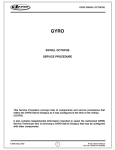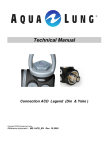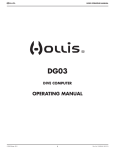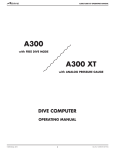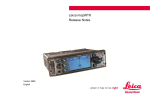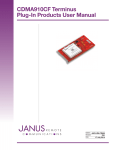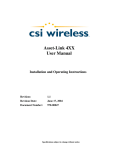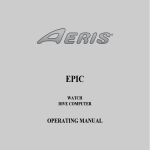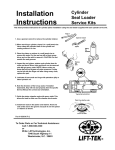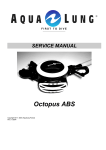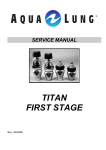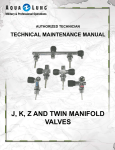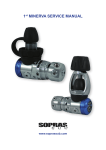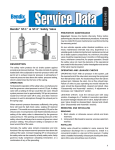Download BALANCED DIAPHRAGM
Transcript
BALANCED DIAPHRAGM FIRST STAGE R O BALANCED DIAPHRAGM (INLINE SWIVEL) FIRST STAGE SERVICE PROCEDURE This Service Procedure conveys lists of components and service procedures that reflect the Regulator as it was configured at the time of the writing (3/24/03). Future issues may also contain Supplemental Information intended to assist the Authorized AERIS Service Technician who is servicing a Balanced Diaphragm First Stage that may be configured with older components. © 2002 Design 2003 1 Product Service Manual Doc. No. 12-7509-r01 (3/24/03) BALANCED DIAPHRAGM FIRST STAGE R O CONTENTS TROUBLESHOOTING .................................................................................................................................................................. 3 DISASSEMBLY PROCEDURE .................................................................................................................................................... 4 REASSEMBLY PROCEDURE ..................................................................................................................................................... 8 ADJUSTMENT ........................................................................................................................................................................... 12 ENVIRONMENTAL KIT REASSEMBLY .................................................................................................................................... 12 PARTS LIST AND EXPLODED VIEW DIAGRAM ...................................................................................................................... 14 REGULATOR GENERAL PROCEDURES REFER TO ............................................................................................................................................................... DOC. 12-7508 SPECIFICATIONS Torques P/N 30.96767 Yoke Retainer P/N 30.94544.200 DIN Filter Retainer P/N 30.96766 DIN Filter Housing P/N 30.93462 HP Port Plug P/N 30.93463 LP Port Plug P/N 30.96769 Swivel Post P/N 30.6580 Environ. End Cap HP Hose into First Stage Body LP Hose into First Stage Body Inflator Hose into First Stage Body 23 to 25 ft-lbs 16 to 18 ft-lbs 16 to 18 ft-lbs 35 to 40 in-lbs 35 to 40 in-lbs 40 to 50 in-lbs 33 to 34 ft-lbs 35 to 40 in-lbs 35 to 40 in-lbs 35 to 40 in-lbs Intermediate Pressure Recommended 138 to 142 psi Acceptable 137 to 143 psi TOOLS REQUIRED Standard Tools Inch Pounds Torque Wrench Foot Pounds Torque Wrench 5/32" Hex Key Socket 1/4" Hex Key Socket 1/2" Open End Wrench 9/16" Open End Wrench 5/8" Open End Wrench 13/16" Open End Wrench 1" Open End Wrench 5/32" Hex Key 1/4" Hex Key (for DIN model) 5/16" Hex Key 3/8" Drive Socket Soft Jawed Vise © 2002 Design 2003 Specialty Tools P/N 30.02302 P/N 30.06671 P/N 30.09311 P/N 30.09315 P/N 30.09520 2 Christo-Lube MCG111 - 2 oz End Cap Tool Kit Filter Circlip Pliers Intermediate Press. Gauge O-ring Tool Kit Product Service Manual Doc. No. 12-7509-r01 (3/24/03) BALANCED DIAPHRAGM FIRST STAGE R O TROUBLE SHOOTING SYMPTOM POSSIBLE CAUSE TREATMENT * Restricted airflow and inhalation resistance through complete system. 1. Cylinder valve not completely opened. 2. Cylinder valve requires service. 3. CONE FILTER (4,12) is contaminated. 1. Open valve completely. 2. Connect Regulator to a different Cylinder. 3. Replace with new and perform a complete service. * Air leakage detected from beneath the ADJUSTMENT CUP (38), inside the END CAP (35). 1. END CAP (35) is loose. 2. DIAPHRAGM (32) is worn or damaged. 3. Seating surface inside BODY (30) is damaged. 1. Tighten END CAP (35) onto BODY (30), using prescribed torque value in Reassembly Procedure. 2. Replace with new. 3. Replace BODY (30) with new. * Air leakage detected from beneath the YOKE, or DIN, Connector. 1. YOKE RETAINER (6), or DIN FILTER HOUSING (14), is loose. 2. RETAINER O-RING (7, 10) is worn or damaged. 1. Tighten onto BODY (30) using prescribed torque value in Reassembly Procedure. 2. Replace with new. * Insufficient intermediate pressure. 1. END CAP (35) is loose. 2. First stage improperly adjusted. 3. DIAPHRAGM SPRING (36) is weakened or damaged. 4. Seating surface of BODY (30) beneath DIAPHRAGM (32) is damaged. * Excessive intermediate pressure/Intermediate pressure creeps. 1. First Stage improperly adjusted. 2. HP SEAT (20) is damaged or worn. 3. HP SEAT O-RING (19) is damaged or worn. 4. Seating surface of HP SEAT (20) or BODY (30) or its Orifice Cone is damaged. 5. RETAINING SPRING (18) is weakened or damaged. © 2002 Design 2003 3 1. Tighten END CAP (35) onto BODY (30), using prescribed torque value in Reassembly Procedure. 2. Readjust according to the procedure specified in Final Adjustment Procedure. 3. Replace with new. 4. Replace BODY (30) with new. 1. Readjust according to Adjustment Procedure. 2. Replace with new. 3. Replace with new. 4. Replace with new. 5. Replace with new. Product Service Manual Doc. No. 12-7509-r01 (3/24/03) BALANCED DIAPHRAGM FIRST STAGE R O DISASSEMBLY PROCEDURE NOTE: Be sure to check and record the Intermediate Pressure and perform the Leak Detection Test outlined in the Initial Inspection Procedures (Doc. 12-7508) prior to Disassembling the Regulator. Review the Troubleshooting Section on page 3 to gain a better idea of which internal parts may be worn, and to better advise your customer of the service that is needed. 1. Before disassembling the First Stage, remove the Low Pressure Hoses with a 9/16" open end wrench, the High Pressure Hose(s) with a 5/8" open end wrench, and the Low Pressure Inflator Hose with either a 9/16" or 1/2" open end wrench. Remove all remaining PORT PLUGS (21, 23) with a 5/32" hex key. Fig. 1 2. Remove and inspect the O-RING(S) now visible on all these items for any signs of decay. If found, discard the O-RING(S). CAUTION: It is important to remove the YOKE/DIN Connector end components first to avoid damage of the HP Seat Cone located inside the BODY (30). NOTE: For units received with Yoke Connectors perform step 3Y. For those with DIN Connectors perform step 3D. 3Y. Yoke Connector Disassembly: A. Remove the KNOB (1) from the YOKE (2) B. Secure the BODY (30) in a soft jawed or well padded vise and apply a thin wall, or modified, 1" open end wrench to the YOKE RETAINER (6). Using firm steady force, turn the YOKE RETAINER counter clockwise to loosen it. DO NOT use impact. Fig. 2 CAUTION: It is important that the wrench is properly seated over the entire hex portion of the YOKE RETAINER to prevent any damage to the part (Fig. 1). CAUTION: Tighten the vise only as needed to hold the First Stage secure, and DO NOT overtighten. Doing so will result in permanent damage, rendering it inoperable. C. Remove the Regulator from the vise and stand it on the work bench with the Yoke end up (Fig. 2). D. Lift the YOKE (2), YOKE RETAINER (6) with RETAINING SPRING (18), and HP SEAT (20) straight up and out of the BODY (30) (Fig. 3) and set them aside. E. Remove the DUST CAP (17), and set it aside. Fig. 3 © 2002 Design 2003 4 Product Service Manual Doc. No. 12-7509-r01 (3/24/03) BALANCED DIAPHRAGM FIRST STAGE R O F. Remove the HP SEAT (20) and RETAINING SPRING (18) from the YOKE RETAINER (6) (Fig. 4). G. Discard the HP SEAT, regardless of its condition, and DO NOT attempt to reuse it. Using a magnifier, closely examine the SPRING for any signs of corrosion, cracks, or other damage. Discard if found and DO NOT attempt to reuse it. H. Using care not to scratch or damage the YOKE RETAINER (6), remove and discard the RETAINER O-RING (7) and HP SEAT O-RING (21), and DO NOT attempt to reuse them. I. Using Internal Circlip Pliers, remove the RETAINING CLIP (3) that retains the CONE FILTER (4). The CONE FILTER should drop out freely into your hand. Discard, and DO NOT attempt to reuse it. Fig. 4 J. Remove the FILTER O-RING (5) and discard, regardless of its condition, and DO NOT attempt to reuse it. 3D. DIN Connector Disassembly: A. Secure the First Stage in a soft-jawed or well padded vise, with the DIN Connector facing up. Apply a 1/4" hex key to the DIN FILTER RETAINER (9) and loosen it in a counter clockwise direction (Fig. 5). Fig. 5 CAUTION: Tighten the vise only as needed to hold the First Stage secure, and DO NOT overtighten. Doing so will result in permanent damage, rendering it inoperable. B. Remove the DIN FILTER RETAINER (9), COUPLER WHEEL (11), FILTER HOUSING SPACER (16), and DUST CAP (17), and set them aside. C. Apply a 13/16" deep socket (recommended), or open end wrench, to the flange at the Base of the DIN FILTER HOUSING (Fig. 6). Using firm, steady force, loosen it in a counter clockwise direction. DO NOT use impact. Fig. 6 CAUTION: If used, it is important that the open end wrench is deep enough to seat entirely over the Flange to avoid any damage to the Seating Surface. D. Remove the Regulator from the vise and stand it on the work bench with the DIN Connector facing up. Lift the DIN FILTER HOUSING (14) with RETAINING SPRING (18) and HP SEAT (20) straight up and out of the BODY (30) (Fig. 7) and set them aside. E. Remove the DIN FACE O-RING (8) and RETAINER O-RING (10) from the DIN FILTER RETAINER. Discard both, regardless of their condition, and DO NOT attempt to reuse them. Fig. 7 © 2002 Design 2003 5 Product Service Manual Doc. No. 12-7509-r01 (3/24/03) BALANCED DIAPHRAGM FIRST STAGE R O F. Turn the DIN FILTER HOUSING (14) over and tap it lightly to drop out the DIN CONE FILTER (12). Remove the FILTER ORING (13) and FILTER HOUSING O-RING (15). Discard them both regardless of their condition and DO NOT attempt to reuse them. G. Remove the HP SEAT (20), RETAINING SPRING (18), and HP SEAT O-RING (19) from the FILTER HOUSING (14) (Fig. 8). H. Discard the HP SEAT and HP SEAT O-RING, regardless of their condition, and DO NOT attempt to reuse them. Using a magnifier, closely examine the RETAINING SPRING for any signs of corrosion, cracks, or other damage. Discard if found and DO NOT attempt to reuse it. Fig. 8 I. Inspect the FILTER HOUSING SPACER (16), checking for any signs of damage or distortion. Discard if found. 4. Turn the Regulator over and stand it on the work bench with the ENVIRONMENTAL CAP (41) facing up and remove the CAP by turning it counter clockwise by hand. DO NOT use tools. 5. Gently peel the Lip of the ENVIRONMENTAL DIAPHRAGM (40) away from the Rim of the ENVIRONMENTAL END CAP (35) and lift it out to remove. Examine the condition of the ENVIRONMENTAL DIAPHRAGM, checking for any signs of wear, distortion, corrosion, or perforation. Discard if found. 6. Turn the First Stage Diaphragm side down and remove the TRANSFER PISTON (39). Check for any signs of wear, distortion, or corrosion. Discard if found. 7. Secure the First Stage in a soft-jawed or well padded vise and apply a Spanner Tool to the ENVIRONMENTAL END CAP (35), turning it counter clockwise to loosen it (Fig. 9). DO NOT remove it at this time. Fig. 9 CAUTION: Tighten the vise only as needed to hold the First Stage secure, and DO NOT overtighten. Doing so will result in permanent damage, rendering it inoperable. 8. Remove the Regulator from the vise and stand it on the work bench with the ENVIRONMENTAL END CAP (35) up. 9. While holding the ENVIRONMENTAL END CAP (35) secure with one hand, turn ADJUSTMENT CUP (38) counter clockwise using a 5/16" hex key to remove it (Fig. 10). 10. Hold the BODY secure with one hand and remove the ENVIRONMENTAL END CAP (35) by turning it counter clockwise. 11. Remove the DIAPHRAGM SPRING (36) and SPRING WASHER (37). Inspect both for any signs of wear or distortion. Discard if found. © 2002 Design 2003 6 Fig. 10 Product Service Manual Doc. No. 12-7509-r01 (3/24/03) BALANCED DIAPHRAGM FIRST STAGE R O 12. Lift out the DIAPHRAGM PLATE (34) and DIAPHRAGM WASHER (33), and inspect for signs of wear or distortion. Discard if found. CAUTION: DO NOT attempt to remove the DIAPHRAGM (32) with the use of a metallic instrument. Doing so will seriously damage the brass Seating Surface of the BODY (30). 13. Remove the DIAPHRAGM (32) from the BODY (30) by pressing down on it with your finger causing the edge to turn upward (Fig. 11). Grasp the edge of the DIAPHRAGM and lift it out. Discard it, regardless of its condition, and DO NOT attempt to reuse it. 14. Remove the BUTTON/PIN (31) and inspect it for signs of wear or distortion. Discard if found. Fig. 11 15. With the use of a penlight and a magnifier, closely examine the Seating Surface of the Orifice Cone inside the BODY (30) for any signs of damage (Fig. 12). If found, discard the BODY and DO NOT attempt to repair or reuse it. 16. Remove all PORT PLUGS (21,23) with a 5/32" hex key. Remove and inspect the PORT PLUG O-RINGS (22,24) for any signs of decay. Discard if found. NOTE: It is not required that the SWIVEL Assembly be removed each time the First Stage is serviced or to clean the BODY (30). However, it will have to be removed to replace the O-RINGS if leakage was detected during the Initial Inspection. Fig. 12 17. To remove the SWIVEL Assembly: A. While holding the BODY (30) secure with one hand, turn the SWIVEL POST (25) counter clockwise with a 5/32" hex key to remove it (Fig. 13). B. Press the SWIVEL POST (25) out of the SWIVEL (29). CAUTION: DO NOT use tools to remove the Swivel O-RINGS. Doing so may damage the sealing surfaces of the SWIVEL Assembly. Pinch (squeeze) them with your fingers of one hand and grasp them with the other (Fig. 14). Fig. 13 C. Remove the SWIVEL O-RING (28) and discard it, regardless of condition, and DO NOT attempt to reuse it. D. Remove the SWIVEL POST O-RINGS (26, 27) and discard them, regardless of their condition, and DO NOT attempt to reuse them. NOTE: There is a small drop of Patch Lock (green color) on the Threads of the SWIVEL POST (25). DO NOT remove this when cleaning the POST. Fig. 14 © 2002 Design 2003 7 Product Service Manual Doc. No. 12-7509-r01 (3/24/03) BALANCED DIAPHRAGM FIRST STAGE R O REASSEMBLY PROCEDURE NOTE: Prior to Reassembly, it is necessary to Inspect all parts, both new and those that are being reused. Check to ensure that O-rings are clean and supple, and that every part and component has been thoroughly cleaned. WARNING: Use only genuine AERIS parts, subassemblies, and components whenever assembling AERIS products. DO NOT attempt to substitute an AERIS part with another manufacturer’s, regardless of any similarity in shape, size, or appearance. Doing so may render the product unsafe, and could result in serious injury or death of the user. Fig. 15 1. Place the Stem of the BUTTON/PIN (31) directly into the Center Hole in the BODY (30), ensuring that it enters without any restriction (Fig. 15). 2. Position the DIAPHRAGM (32) flat, directly over the opening of the BODY (28). Gently push the Edges of the DIAPHRAGM down inside the Internal Threads of the BODY, one Thread at a time. Rotate the BODY while doing this, to facilitate an even seating of the DIAPHRAGM. Closely inspect to ensure it is well seated at the Base of the Threads (Fig. 16). CAUTION: DO NOT force the DIAPHRAGM into the BODY in a manner that will damage either the Lip or Surface of the DIAPHRAGM, or the Threads of the BODY. The use of a sharp instrument, such as a screwdriver, is to be strictly avoided. 3. Place the DIAPHRAGM WASHER (33) into the BODY (30) on top of the DIAPHRAGM (32) with the Collar facing up. Fig. 16 4. Lay the DIAPHRAGM PLATE (34) into the Center of the DIAPHRAGM (32), with its Flat Surface against the DIAPHRAGM. 5. Thread the ENVIRONMENTAL END CAP (35) into the BODY (30), turning clockwise by hand until secure. 6. Secure the BODY (30) in a soft jawed or well padded vise, and using the End Cap Hook/Wrench Link (from End Cap Tool) and a foot-pounds torque wrench, tighten the ENVIRONMENTAL END CAP (35), into the BODY to a torque of 33 to 34 ft-lbs (Fig. 17). CAUTION: Tighten the vise only as needed to hold the First Stage secure, and DO NOT overtighten. Doing so will result in permanent damage, rendering it inoperable. 7. Remove the Regulator from the vise and place it on the work bench. Apply a very light film of lubricant (Christo Lube MCG #111) to both Ends of the DIAPHRAGM SPRING (36), and place it down onto the DIAPHRAGM PLATE (34). Fig. 17 © 2002 Design 2003 8 Product Service Manual Doc. No. 12-7509-r01 (3/24/03) BALANCED DIAPHRAGM FIRST STAGE R O 8. Place the SPRING WASHER (37) directly onto the Upper End of the DIAPHRAGM SPRING (36) and install the ADJUSTMENT CUP (38) into the ENVIRONMENTAL END CAP (35). Using a 5/16" hex key, turn the ADJUSTMENT CUP clockwise until 3 OR 4 Threads are showing. NOTE: The more the ADJUSTMENT CUP is turned in at this time, the more difficult it will be to install the YOKE or DIN Connector. NOTE: For units received with Yoke Connectors perform step 9Y, for those with DIN Connectors perform step 9D. Fig. 18 9Y. Yoke Connector Reassembly: A. Install the FILTER O-RING (5) into the inner groove of the YOKE RETAINER (6) (Fig. 18). B. Install the CONE FILTER (4) into the YOKE RETAINER (6) and install the RETAINING CLIP (3) into the Groove above it, using Internal Circlip Pliers (Fig. 19). NOTE: Close examination of the RETAINING CLIP will show that one side is slightly rounded and the other is flat. Install with the flat side facing out of the YOKE RETAINER to ensure greater holding strength. Fig. 19 C. Lightly lubricate and install the RETAINER O-RING (7) onto the Groove at the Base of the Threads. D. Lightly lubricate and install the HP SEAT O-RING (19) into the Inner Bore of the YOKE RETAINER (6) (Fig. 20). E. Lightly lubricate both ends of the RETAINING SPRING (18) and place it on the Barrel of the YOKE RETAINER (6). F. Lightly lubricate the lower 1/4" of the Shaft of the HP SEAT (20) and carefully guide the Shaft of the HP SEAT through the RETAINING SPRING (18) and into the HP SEAT O-RING (19) in the Inner Bore of the YOKE RETAINER (6) (Fig. 21). Fig. 20 NOTE: Before proceeding further, hold the BODY (30) at a slight angle, so that you can see the Stem End of the BUTTON/PIN (31) protruding through the Center of the machined Orifice Cone. When you insert the YOKE RETAINER/ HP SEAT Assembly into the center of the opening in the BODY, you must carefully guide the center opening of the HP SEAT (20) onto the BUTTON/PIN ensuring that the BUTTON/ PIN enters directly into the opening of the HP SEAT without any restriction. CAUTION: Improper alignment of the BUTTON/PIN and the HP SEAT during installation will result in damage to the Seating Surface of the HP SEAT, requiring its replacement. © 2002 Design 2003 9 Fig. 21 Product Service Manual Doc. No. 12-7509-r01 (3/24/03) BALANCED DIAPHRAGM FIRST STAGE R O G. Place the DUST CAP (17) onto the Rim of the BODY (30) (Fig. 22). H. Insert the threaded End of the YOKE RETAINER/HP SEAT Assembly through the YOKE (2), facing opposite the End that holds the KNOB (1). I. Holding the YOKE RETAINER/HP SEAT Assembly and YOKE together insert them straight down into/onto the BODY. Ensure that the Threads seat properly and hand tighten in a clockwise direction until secure (Fig. 23). J. Secure the Regulator in a soft jawed or well padded vise, with the YOKE End facing straight up. Fig. 22 CAUTION: Tighten the vise only as needed to hold the first stage secure, and DO NOT overtighten. Doing so will result in permanent damage, rendering it inoperable. K. Using a thin-wall, or modified, 1" open end wrench that is properly seated over the entire Hex Portion of the YOKE RETAINER, tighten it to a torque of 23 to 25 ft-lbs. L. Install the KNOB (1) into the YOKE (2). 9D. DIN Connector Reassembly: A. Lightly lubricate and install the DIN FILTER HOUSING ORING (15) into the Groove on the End of the DIN FILTER HOUSING (14). B. Lightly lubricate and install the HP SEAT O-RING (19) into the Inner Bore of the DIN FILTER HOUSING (14). C. Lightly lubricate both ends of the RETAINING SPRING (18) and place it on the Barrel of the DIN FILTER HOUSING (14). Fig. 23 D. Lightly lubricate the lower 1/4" of the Shaft of the HP SEAT (20) and carefully guide the Shaft of the HP SEAT through the RETAINING SPRING (18) and into the HP SEAT O-RING (19) in the Inner Bore of the DIN FILTER HOUSING (14). NOTE: Before proceeding further, hold the BODY (30) at a slight angle, so that you can see the Stem End of the BUTTON/PIN (31) protruding through the Center of the machined Orifice Cone. When you insert the YOKE RETAINER/ HP SEAT Assembly into the center of the opening in the BODY, you must carefully guide the center opening of the HP SEAT (20) onto the BUTTON/PIN ensuring that the BUTTON/ PIN enters directly into the opening of the HP SEAT without any restriction. © 2002 Design 2003 10 Product Service Manual Doc. No. 12-7509-r01 (3/24/03) BALANCED DIAPHRAGM FIRST STAGE R O CAUTION: Improper alignment of the BUTTON/PIN and the HP SEAT during installation will result in damage to the Seating Surface of the HP SEAT, requiring its replacement. E. Lubricate and install the FILTER O-RING (13) into the DIN FILTER HOUSING (14), at the Base of the Filter Cavity. F. Install the DIN FILTER HOUSING/HP SEAT Assembly straight down into the BODY (30), so that the Threads seat properly. Hand tighten in a clockwise direction until secure (Fig. 24). G. Secure the Regulator in a soft jawed or well padded vise, with the DIN Connector End facing straight up. Fig. 24 CAUTION: Tighten the vise only as needed to hold the First Stage secure, and DO NOT overtighten. Doing so will result in permanent damage, rendering it inoperable. H. Using a 13/16" deep socket (recommended), or open end wrench, that is properly seated over the entire Seating Surface of the Flange of the DIN FILTER HOUSING (14), tighten it to a torque of 16 to 18 ft-lbs. I. Place the DUST CAP (17) onto the Rim of the BODY (30) and position the FILTER HOUSING SPACER (16) on it (Fig. 25). J. Install the DIN COUPLER WHEEL (11) down over the Barrel of the DIN FILTER HOUSING (14), with the Threaded End facing up. K. Insert the DIN CONE FILTER (12) into the DIN FILTER HOUSING (14). L. Lubricate and install the DIN FACE O-RING (8) and RETAINER O-RING (10) onto the DIN FILTER RETAINER (9). Fig. 25 M. Insert the Threaded End of the DIN FILTER RETAINER (9) through the DIN COUPLER WHEEL (11) into the DIN FILTER HOUSING (14), and tighten until secure. Using a 1/4" hex socket, tighten it to a torque of 16 to 18 ft-lbs. 10. Lubricate and install PORT PLUG O-RINGS (22, 24) onto the PORT PLUGS (21, 23). While holding the BODY (30) secure, install the PORT PLUGS into the BODY, tightening clockwise with a 5/32" hex key socket to a torque of 35 to 40 in-lbs. 11. If the SWIVEL Assembly was removed and disassembled: A. Lightly lubricate and install the SWIVEL POST O-RINGS (26, 27) in the grooves on the Shaft of the SWIVEL POST (25). B. Lightly lubricate and install the SWIVEL O-RING (28) in the groove at the Base of the Threads of the SWIVEL POST (25). © 2002 Design 2003 11 Product Service Manual Doc. No. 12-7509-r01 (3/24/03) BALANCED DIAPHRAGM FIRST STAGE R O C. Insert the SWIVEL POST (25) into the SWIVEL (29). D. While holding the BODY (30) secure, install the SWIVEL Assembly into the LP Port located below the flat portion of the BODY (Fig. 26), and tighten it clockwise with a 5/32" hex key socket to a torque of 40 to 50 in-lbs. 12. Lubricate and install all Hose O-rings onto Hoses and install the Hoses into the BODY (30). While holding the BODY secure, tighten the LP Second Stage Hose(s) clockwise with a 9/16" open end wrench, the HP Hose(s) with a 5/8" open end wrench, and the LP Inflator Hose(s) with either a 9/16" or 1/2" open end wrench, all to a torque of 35 to 40 in-lbs. Fig. 26 CAUTION: Be certain NOT to install any Low Pressure Hose into a High Pressure Port using an adaptor. ADJUSTMENT 1. Connect a recently calibrated Intermediate Pressure Test Gauge to a Low Pressure Hose, and connect the First Stage with Second Stage and Low Pressure Test Gauge to a pure breathing gas source of 3000 PSI. Slowly open the supply valve to pressurize the Regulator, and purge the Second Stage several times. 2. Adjust the Intermediate Pressure, if necessary, to read 138 to 142 PSI by turning the ADJUSTMENT CUP (38) clockwise to increase the pressure or counter clockwise to decrease it (Fig. 24). NOTE: Turn the ADJUSTMENT CUP no more than 1/8 of a turn at a time, pausing to purge the Second Stage several times to gain an accurate reading of the Intermediate Pressure before adjusting further. NOTE: Ensure that the Intermediate Pressure holds stable at 138 to 142 PSI, and does not creep or fluctuate after the Second Stage has been purged several times. If creeping is detected, refer to the Troubleshooting Section on page 3 to determine possible cause and treatment. © 2002 Design 2003 12 Product Service Manual Doc. No. 12-7509-r01 (3/24/03) BALANCED DIAPHRAGM FIRST STAGE R O ENVIRONMENTAL END REASSEMBLY 1. Insert the TRANSFER PISTON (39) into the ENVIRONMENTAL END CAP (35) (Fig. 27). 2. Turn the air supply off and bleed off all pressure. 3. Insert the ENVIRONMENTAL DIAPHRAGM (40) over the Top of the ENVIRONMENTAL END CAP (35) on top of the TRANSFER PISTON (39) with the thin Perimeter Seal facing down. Ensure that the Perimeter Seal is seated completely into the circular Groove in the ENVIRONMENTAL END CAP (Fig. 28). Fig. 27 4. Thread the ENVIRONMENTAL CAP (41) onto the ENVIRONMENTAL END CAP (35), being very careful to avoid cross threading, and tighten clockwise by hand until secure. DO NOT use tools to tighten. 5. Turn on the air supply, purge the Second Stage several times, and check once more to ensure proper Intermediate Pressure of 138 to 142 psi. Fig. 28 © 2002 Design 2003 13 Product Service Manual Doc. No. 12-7509-r01 (3/24/03) BALANCED DIAPHRAGM FIRST STAGE R O Dia. Part No. No. Dia. Part No. No. Description YOKE VERSION 1c 30.96809 2c 30.96562 3c 30.93530 4a 30.93545 5a 30.9013 6c 30.96767 7a 30.96508 KNOB YOKE CLIP, RETAINING FILTER, CONE O-RING, FILTER RETAINER, YOKE O-RING, RETAINER DIN VERSION 8a• 30.96374 9c 30.94544.200 10a• 30.9012 11c 30.96806 12a• 30.94546 13a• 30.9011 14c 30.96766 15a• 30.96508 16c• 30.96763 O-RING, DIN FACE RETAINER, DIN FILTER O-RING, RETAINER WHEEL, DIN COUPLER FILTER, DIN CONE O-RING, FILTER HOUSING, DIN FILTER O-RING, FILTER HOUSING SPACER, FILTER HOUSING Description YOKE AND DIN VERSIONS 17c 30.96807 CAP, DUST 18c 30.96512 SPRING, RETAINING 19a• 30.96498 O-RING, HP SEAT 20a• 30.96490 SEAT, HP 21c 30.93462 PLUG, HP PORT 22c 30.93.904 O-RING, HP PORT PLUG 23c 30.93463 PLUG, LP PORT 24c 30.93.903 O-RING, LP PORT PLUG 25c 30.96769 POST, SWIVEL 26a• 30.9012 O-RING, SWIVEL POST OUTER 27a• 30.9012 O-RING, SWIVEL POST INNER 28a• 30.9903 O-RING, SWIVEL 29c 30.96768 SWIVEL 30c 30.96765 BODY 31c 30.96576 BUTTON/PIN 32c 30.96574 DIAPHRAGM 33c 30.96699 WASHER, DIAPHRAGM 34c 30.96577 PLATE, DIAPHRAGM 35c 30.96580 CAP, ENVIRONMENTAL END 36c 30.96717 SPRING, DIAPHRAGM 37b 30.96524 WASHER, SPRING 38c 30.96518 CUP, ADJUSTMENT 39c 30.96516 PISTON, TRANSFER 40c 30.96511 DIAPHRAGM, ENVIRONMENTAL 41c 30.96711 CAP, ENVIRONMENTAL SERVICE PARTS KITS 30.90011 KIT, YOKE CONNECTION SERVICE PARTS (Includes all Bold items.) TBD KIT, DIN CONNECTION SERVICE PARTS (Includes all • items) 8• 9 10• 3 4 5 11 12• 13• 14 6 15• 16 25 7 26• 27• 28• 29 30 31 1 2 17 © 2002 Design 2003 18 20• 19• 22 24 21 23 14 32 33 34 35 36 37 38 39 40 41 Product Service Manual Doc. No. 12-7509-r01 (3/24/03)














